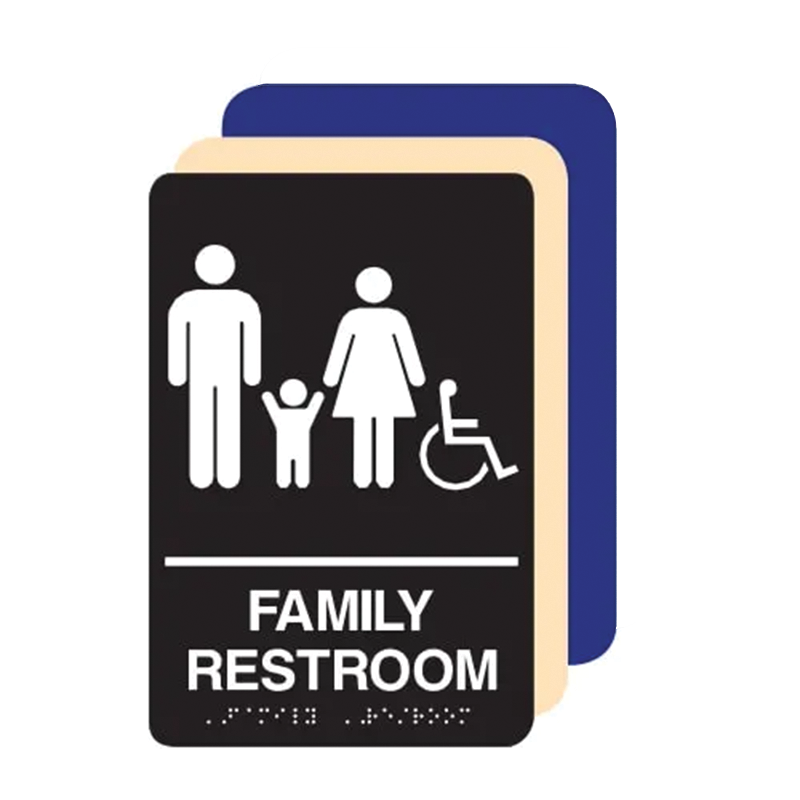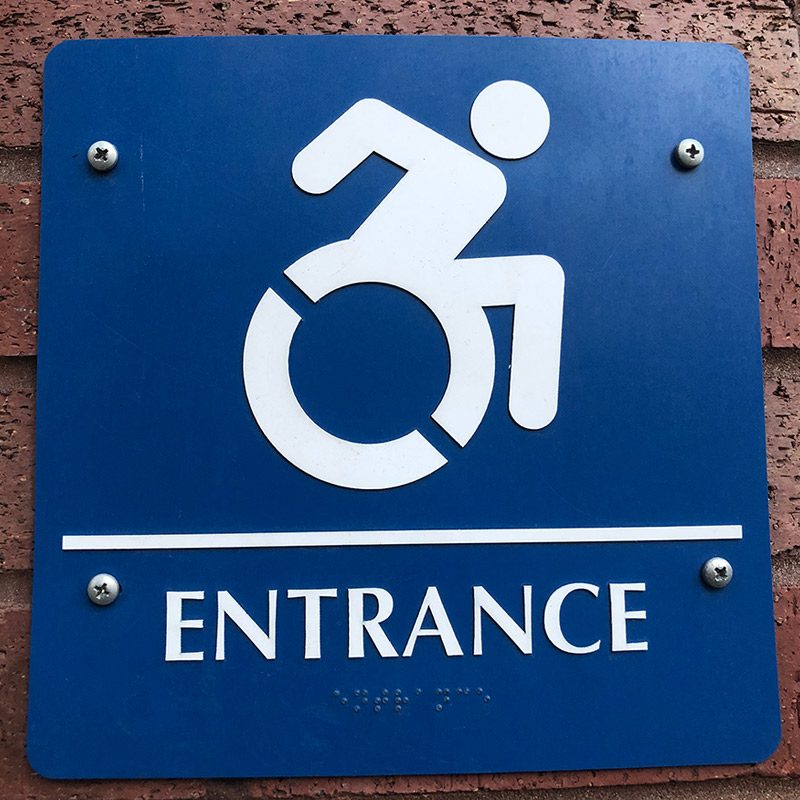The Influence of ADA Signs on Community Access
The Influence of ADA Signs on Community Access
Blog Article
How ADA Signs Transform Rooms for People With Disabilities
The makeover of rooms with ADA indicators for individuals with disabilities is a profound testament to the power of ease of access. By sticking to ADA conformity, settings become risk-free and accessible, with signs that function crucial components like high-contrast colors and Braille, therefore improving exposure and comprehension. Beyond simple capability, these indicators add to area inclusion, offering a sense of empowerment and belonging. As we look towards future fads in accessible signage, one have to consider just how developing modern technologies could additionally revolutionize these rooms. What chances and difficulties lie in advance in ensuring these rooms remain inclusive for all?

Relevance of ADA Compliance
Guaranteeing ADA compliance is not just a legal commitment but also a societal dedication to inclusivity and ease of access. By sticking to the standards stated in the Americans with Disabilities Act (ADA), companies demonstrate their commitment to creating environments where individuals with impairments can navigate and involve without barriers. ADA compliance is critical in eliminating discrimination, fostering equal rights, and promoting self-reliance for individuals with impairments.
Organizations and public organizations benefit dramatically from ADA compliance. By ensuring centers are accessible to everyone, companies can bring in a broader client base, including the 61 million Americans living with specials needs.
Additionally, ADA compliance is a cornerstone of universal layout, which stresses producing rooms that fit all individuals, no matter their capacities. By executing certified signage and attributes, companies add to a more fair society, where all participants can get involved fully. Eventually, ADA conformity goes beyond lawful obligation, embodying a social value that focuses on empowerment and level playing field for everybody.
Enhancing Navigating and Safety
Browsing spaces with self-confidence and security is critical for individuals with disabilities, and ADA-compliant signs plays an essential function in achieving this objective. These signs are developed with particular functions to provide to the varied requirements of individuals with different handicaps, thereby facilitating smoother and safer navigation throughout public and personal spaces. By giving clear, standardized info, ADA signs decrease complication and promote a greater sense of freedom for individuals who rely upon them.
The calculated positioning of ADA indications ensures that crucial info is accessible to everyone, including those with aesthetic, auditory, or cognitive problems. As an example, tactile and Braille components on indications aid visually damaged people individually find departures, washrooms, and other crucial locations. In emergency situation situations, ADA signs add to reliable evacuations by plainly marking emergency leaves and routes, thus boosting safety for all occupants.
Moreover, ADA-compliant indications cultivate a comprehensive atmosphere by addressing the unique navigating obstacles faced by individuals with handicaps. This not just aids in their individual safety and security yet additionally encourages engagement in social activities by promoting equal access to civil services and facilities. Eventually, efficient ADA signage transforms areas right into easily accessible, secure, and inviting settings for everyone.
Functions of Reliable ADA Indicators
To produce efficient ADA signs, it is critical to integrate specific functions that address the varied access needs of people with disabilities. One important feature is the usage of high-contrast shades, which substantially improve exposure for people with aesthetic disabilities. The background and message ought to contrast sharply to make certain the information is conveniently noticeable. Furthermore, the text should remain in a sans-serif font style, as these fonts offer more clear readability at a range.
An additional crucial feature is responsive components, such as increased personalities and Braille, promoting access for visually impaired individuals. The increased characters ought to be at the very least 1/32 inch over the surface area, allowing for easy touch analysis. Braille should be placed directly below corresponding text, making certain uniformity and simplicity of navigating.
The placement of ADA indications is also crucial for their efficiency. They should be installed at a height in between 48 to 60 inches from the ground to ensure they are accessible for people in wheelchairs or those with flexibility help. Moreover, indicators must be located near elevators, restrooms, and entrances, making sure that important info is obtainable specifically when needed. By integrating these functions, ADA signs can substantially enhance wayfinding and ease of access for all.
Effect On Neighborhood Addition
ADA indications dramatically add to area incorporation by guaranteeing that public rooms are accessible and accessible for individuals with disabilities. These indications, made in conformity with the Americans with Disabilities Act (ADA), feature tactile aspects, braille, and high-contrast colors, assisting not only those with visual problems but a diverse visit our website array of impairments - ADA Signs. Consequently, they play a pivotal duty in developing environments where people with specials needs can take part completely and separately in neighborhood life

Additionally, ADA indicators aid institutions and organizations satisfy legal commitments, thus preventing potential discrimination claims and improving their track records as comprehensive entities. Inevitably, ADA indications are essential devices in the continuous effort to build more accessible and fair areas for everybody.
Future Trends in Accessible Signs
Exactly how will technological improvements shape the future of accessible signs? The combination of sophisticated innovations assures to reinvent exactly how people with specials needs connect go to website with their atmospheres. One appealing growth is the use of electronic and smart signage that can dynamically adjust web content to accommodate individual needs. Electronic signs geared up with sensors and connectivity can engage with individual tools to give tailored information, such as text-to-speech for aesthetically impaired users or simplified graphics for those with cognitive handicaps.
Enhanced reality (AR) also holds substantial potential. AR applications can overlay digital information onto real-world environments, giving customers with enhanced navigational aids and contextual details (ADA Signs). This can be especially useful in complicated setups like flight terminals or huge public locations where typical signs may fail
One more emerging fad is the unification of Web of Points (IoT) innovation Homepage to develop a network of interconnected indicators. This enables real-time updates and raised ease of access, adjusting to modifications in the environment or customer demands. In addition, with the growing emphasis on inclusivity, future guidelines might push for even a lot more innovative signs solutions, ensuring universal gain access to and promoting a more inclusive culture for all people.
Conclusion
ADA signs play an essential role in changing spaces for individuals with handicaps by making certain availability and promoting self-reliance. Conformity with ADA requirements enhances navigation and safety with using high-contrast colors, responsive aspects, and Braille. These functions foster community incorporation and equip people by developing barrier-free environments. The continuous development of available signs assures more developments in inclusivity, eventually enhancing the total experiences of individuals with handicaps and reinforcing their sense of belonging in neighborhood life.
The change of areas through ADA indicators for individuals with specials needs is a profound testimony to the power of availability.To develop reliable ADA indicators, it is necessary to integrate specific functions that deal with the varied ease of access requirements of individuals with handicaps.ADA indicators dramatically contribute to area incorporation by ensuring that public areas are obtainable and accessible for people with disabilities.By promoting the simplicity of motion and understanding within public spaces, ADA signs cultivate a feeling of belonging and empowerment among people with impairments.ADA indicators play a vital duty in transforming spaces for people with impairments by making certain accessibility and promoting self-reliance.
Report this page